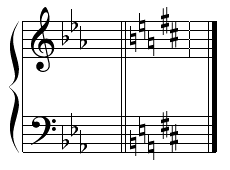Disclaimer for new readers: Much like math courses, each blog post here builds upon the concepts which have been introduced in previous posts–it is cumulative. If you do not know much about music theory, I recommend checking out earlier posts.
Today, we continue our study of harmony. We have discussed modes in the past, but not exactly how to apply them. That’s where modal interchange comes in.
Before we go any farther, a few important terms.
Modulation is changing keys for an extended period of time. Tonicization is changing keys for a short period of time through the use of a secondary dominant (this was discussed in last week’s post). Modal interchange is using chords from a parallel key while retaining the same tonal center. Tonal center refers mainly to the root note of the 1 chord. Parallel key and mode are synonymous terms which refer to scales containing different notes but sharing the same root note.
The important difference between modulation and modal interchange is a modulation changes the tonal center, while modal interchange does not.

Note: Modulation results in a change in key signature, as pictured above.
Let’s review the modes of the major scale and their related seventh chords, pictured in this chart:
| Scale | 1 (Root) | 2 | 3 | 4 | 5 | 6 | 7 |
|---|---|---|---|---|---|---|---|
| Ionian | IMaj7 | IIm7 | IIIm7 | IVMaj7 | V7 | VIm7 | VIIm7♭5 |
| Dorian | Im7 | IIm7 | ♭IIIMaj7 | IV7 | Vm7 | VIm7♭5 | ♭VIIMaj7 |
| Phrygian | Im7 | ♭IIMaj7 | ♭III7 | IVm7 | Vm7♭5 | ♭VIMaj7 | ♭VIIm7 |
| Lydian | IMaj7 | II7 | IIIm7 | #IVm7♭5 | VMaj7 | VIm7 | VIIm7 |
| Mixolydian | I7 | IIm7 | IIIm7♭5 | IVMaj7 | Vm7 | VIm7 | ♭VIIMaj7 |
| Aeolian | Im7 | IIm7♭5 | ♭IIIMaj7 | IVm7 | Vm7 | ♭VIMaj7 | ♭VII7 |
| Locrian | Im7♭5 | ♭IIMaj7 | ♭IIIm7 | IVm7 | ♭VMaj7 | ♭VI7 | ♭VIIm7 |
| Melodic Minor | ImMaj7 | IIm7 | ♭IIIMaj7#5 | IV7 | V7 | VIm7♭5 | VIIm7♭5 |
| Harmonic Minor | ImMaj7 | IIm7♭5 | ♭IIIMaj7#5 | IVm7 | V7♭9 | ♭VIMaj7 | VIIo7 |
Modal interchange is sometimes referred to as “chord borrowing,” as essentially it is borrowing chords from a different mode. The most common use of modal interchange is between the major scale and a parallel minor mode (usually aeolian or harmonic minor).
For example, the minor four (iv) chord, one of the most popular tricks in the songwriter’s toolkit, is an example of modal interchange. You can hear it featured prominently in the music of the Beatles, Stevie Wonder, Radiohead, and way more. The minor seventh dominant (bVII7) chord–sometimes referred to as the “backdoor”–is another common example derived from interchange with a minor mode.
Modal interchange is a technique that can make a chord progression more interesting, exciting, and flavorful. By briefly departing into the non-diatonic territory of another mode, the listener is surprised but not completely disoriented, as the progression quickly finds its way back to the tonic. It is a concept that unlocks many new doors for composers.
The most interesting thing about this blog is the fact that you thoroughly detail the mechanics that go into creating the perfect harmony. I won’t lie, I know nothing about the logistics of note-creation, and up until I began analyzing your blogs, I ignorantly believed that you could just fling a strand of a guitar, or sing the perfect note, or press the correct key to create a harmony, but this concise explanation totally opens my eyes to the specifics of the music world. Great read Ethan!
I am even closely knowledgable as compared to you when it comes to music theory. Through these posts, your imminent passion is evident. I am beginning to understand that concepts you are talking about, and you make them look extremely concise yet detailed, and easy to read. I look forward to what you are going to write about next week.